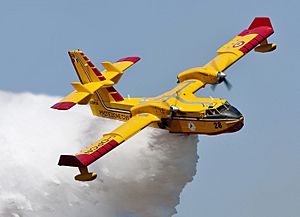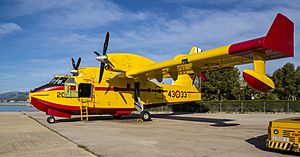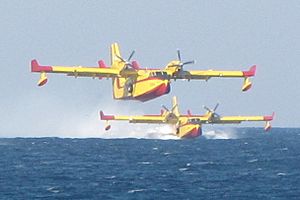Canadair CL-415 facts for kids
Quick facts for kids CL-415 / DHC-515 |
|
|---|---|
 |
|
| Role | Aerial firefighting |
| Manufacturer | Canadair Bombardier Aerospace De Havilland Canada |
| First flight | 6 December 1993 |
| Introduction | 1994 |
| Status | Active service |
| Primary users | Vigili del Fuoco (Italy) Sécurité Civile (France) Hellenic Air Force (Greece) Quebec Service aérien gouvernemental |
| Produced | CL-415: 1993–2015 / DHC-515: 2022-present |
| Number built | 95 |
| Developed from | Canadair CL-215 |
The Canadair CL-415 (also known as the Super Scooper or Bombardier 415) and the newer De Havilland Canada DHC-515 are special airplanes. They are designed to land on water and take off again, making them amphibious aircraft. These planes were first built by a company called Canadair. Later, Bombardier and then Viking Air and De Havilland Canada took over their production.
The CL-415 is based on an older plane, the Canadair CL-215. It was made especially for aerial firefighting, which means fighting fires from the sky. But it can also do other important jobs, like search and rescue missions or carrying supplies.
Work on the CL-415 started in the early 1990s. People saw that there was a need for a newer, more powerful version of the CL-215. This new plane would use turboprop engines, which are more efficient. The CL-415 began production in 2003. It had many modern updates, especially in its cockpit and how it flew through the air (its aerodynamics). These changes made it perform much better.
Bombardier owned the plane's production until 2015. In 2016, Viking Air bought the rights to the CL-415. They planned to make an even newer version, called the CL-515. This plane was later renamed the DHC-515 Firefighter. It will be built in Calgary, Alberta, by De Havilland Canada.
Contents
How the Super Scooper Was Developed
Starting the Idea
The CL-215 was introduced in 1966. It was the first airplane made just for dropping water on fires. A total of 125 of these planes were built. The last one was delivered in May 1990.
In 1987, companies wanted planes with more powerful and reliable engines. So, Canadair decided to upgrade 17 of their CL-215 planes. They put new PW123AF turboprop engines into them. These new engines made the planes 15 percent more powerful. They also made them more reliable and safer. The upgraded planes were called the CL-215T.
Even though the CL-215T was good, the company knew that not enough people wanted a completely new plane. But the CL-215T still had many improvements. It had power-assisted flight controls and air conditioning in the cockpit. It also had better electrical and navigation systems. You could tell the CL-215T apart by new parts on its wings and tail that helped it fly better.
After the success of the CL-215T, the company decided to build a brand-new plane called the CL-415. This new plane would be even better. The first CL-415 flew on December 6, 1993. The first planes were delivered in November 1994. A year later, a CL-415 from the Quebec Government went on a 180-day trip. It visited 21 countries to show what it could do. That same year, Bombardier planned to make six more improvements to the CL-415. They wanted it to be able to do even more different jobs.
Many countries quickly ordered the CL-415. By July 1996, 37 of these planes were being used in Canada, France, Italy, and Spain. From 1998, the CL-415 was put together at Bombardier Aerospace in North Bay, Ontario. It was tested on Lake Nipissing. In the 2010s, fewer CL-415s were sold. Bombardier stopped making new ones in October 2015, after building 95 planes. But they still sold the planes and helped keep the existing ones flying.
The Viking Era: A New Chapter
For many years, Bombardier grew a lot. But in the 2010s, they faced money problems. This was mainly because it cost a lot to develop their new CSeries passenger jet.
A smaller company called Viking Air started by making parts for planes. They even made parts for some of Bombardier's older planes that were no longer being built. This helped keep those planes flying. In 2008, Bombardier sold the designs and rights for all their older de Havilland planes to Viking.
On June 20, 2016, Viking Air announced they were buying the rights to the CL-415 from Bombardier. This also included the older CL-215 and CL-215T models. The deal was completed on October 3, 2016. Soon after, Viking started designing a newer version, the CL-515.
In December 2018, a special CL-415 flight simulator was approved. This simulator could even copy how the plane scoops water and drops it. Before this, pilots had to train by flying real planes.
On June 21, 2019, Indonesia announced they would buy six CL-515s. They expect to receive them in 2024. On March 31, 2022, Viking Air (through De Havilland Canada) renamed the CL-515 to the DHC-515. They plan to build it in Calgary, Alberta. Twenty-two European customers have already shown interest in buying these new planes.
How the CL-415 is Designed

The CL-415 has a modern cockpit and improved aerodynamics. It also has changes to its water-release system. All these features make it a great firefighting flying boat for finding and putting out forest fires. Compared to the CL-215, the CL-415 can carry more weight and fly faster. This makes it better at its job.
Its two Pratt & Whitney Canada PW123AF turboprop engines are very powerful. Each engine can create a lot of thrust. These engines are placed closer to the main body of the plane than on the CL-215. To help the plane stay stable in the air, it has a special part called an inverted leading edge slat near the right side of its tail. It also has winglets on its wings to help it fly straight.
The CL-415 can scoop up to 6,140 liters (about 1,622 US gallons) of water from a lake or ocean. It can even mix the water with a special chemical foam if needed. Then, it drops the water on a fire without having to go back to an airport to refill. The CL-415 was made to quickly deliver large amounts of fire suppressant. The water is stored in big tanks under the floor of the plane. The plane is built to be strong and last a long time. It uses materials that resist corrosion, especially treated aluminum, so it can be used in salt water. The CL-415 is known for being easy to control on the water. The newer CL-515 can hold even more water, up to 7,000 liters (1,850 US gallons). It can refill its tanks in just 14 seconds!
The plane needs about 1,340 meters (4,396 feet) of clear space to scoop water. It can fly down from 15 meters (49 feet) high, scoop 6,137 liters (1,621 US gallons) of water in a 12-second run over 410 meters (1,345 feet) on the water, and then climb back to 15 meters high. It can also pick up smaller amounts of water in tighter areas. It can even turn while scooping water if needed. Pilots control the water bombing system from a special panel in the cockpit. They can choose different ways to drop the water. There is also a manual lever to dump all the water quickly in an emergency. Bombardier says the plane can make about 6.9 water drops for every hour it flies. There is a CL-415GR version that can carry more weight. There is also a CL-415 multi-role model that can be used for search and rescue and carrying supplies.
How the CL-415 is Used
Because it's so good at fighting fires, the CL-415 is often called the "Super Scooper." In 2006, it won an award in Spain called the Batefuegos de oro (gold fire extinguisher). The award said it was "the most efficient tool for the aerial combat of forest fires." It also said the plane was "key to the organization of firefighting in a large number of countries."
By 1999, 51 of these planes had been ordered. Most operators use the CL-415 for fighting fires and for maritime search and rescue missions over the ocean. While these aircraft are very reliable, some have been lost in service over the years.
Different Versions of the Plane
- CL-415
- This is the original model. 86 of these were built.
- CL-415MP
- This version is used for patrolling the sea. Three of these were built.
- CL-415GR
- This is an improved version for the Hellenic Air Force (Greece). It can carry heavier loads. Six of these were built.
- CL-415EAF
- This stands for "Enhanced Aerial Firefighter." In 2019, six of these planes were ordered by a company called Bridger Aerospace. They were expected to be delivered in April 2020.
- DHC-515 (formerly CL-515)
- This is the updated version from Viking Air in British Columbia. It was later renamed the DHC-515. It will be built in Calgary, Alberta.
Who Uses These Planes?
In 2016-2019, there were 164 CL-215 and CL-415 planes being used in 11 countries.
| Country | Current Fleet | On Order | Operators |
|---|---|---|---|
| Canada | 64 | 2019 figures, all others 2016:
|
|
| Croatia | 6 | 2 | Croatian Air Force / Croatian Fire Brigade 885th Firefighting Squadron, 6 CL-415, 2 CL-515 in order |
| France | 12 | Sécurité Civile | |
| Greece | 17 | 8 | Hellenic Air Force, 7 CL-415, 10 CL-215, 8 CL-515 on order |
| Indonesia | 0 | 6 |
On 21 June 2019, the Indonesian Ministry of Defense announced it was purchasing six CL-515s for delivery in 2024. |
| Italy | 18 | Vigili del Fuoco | |
| Malaysia | 2 | Malaysian Maritime Enforcement Agency (firefighting) | |
| Morocco | 6 | 6 | Royal Moroccan Air Force |
| Portugal | 0 | 2 | Portuguese Air Force purchased two CL-515s in 2022 to fight forest fires. Both units will be received in 2026 |
| Spain | 25 | Spanish Air and Space Force, operates 14 CL-215 and 4 CL-415s, 43rd Group of the Air Force | |
| United States | 10 |
|
|
| Total | 160 | 21 |
Specifications (CL-415)
Data from Viking
General characteristics
- Crew: 2
- Capacity: 6,137 L (1,350 imp gal; 1,621 US gal) (waterbombing), up to 18 paratroops, up to 2,903 kg (6,400 lb) of cargo
- Length: 20.4 m (66 ft 11 in)
- Wingspan: 28.38 m (93.11 ft)
- Height: 9.01 m (29.55 ft)
- Wing area: 100 m2 (1,080 sq ft)
- Aspect ratio: 8.03
- Empty weight: 13,608 kg (30,000 lb)
- Gross weight: 21,319 kg (47,000 lb) Maximum After-scooping Weight
- Max takeoff weight: 19,890 kg (43,850 lb) Firefighting, Land
- Fuel capacity: 4,650 kg (10,250 lb) 5812 L ( 1535 US Gal; 1278 imp Gal)
- Cabin volume: 35.6 m3 (1,260 cu ft)
- Powerplant: 2 × Pratt & Whitney Canada PW123AF turboprop, 1,775 kW (2,380 hp) each ISA+20 °C Flat rated
- Propellers: 4-bladed Hamilton Sundstrand 14SF-19, 3.97 m (13 ft 0 in) diameter Fully reversible, feathering blades
Performance
- Maximum speed: 359 km/h (223 mph; 194 kn) Max Cruise
- Cruise speed: 333 km/h (207 mph; 180 kn) Normal Cruise
- Stall speed: 126 km/h (78 mph; 68 kn) MLW, Landing Configuration
- Ferry range: 2,427 km (1,508 mi; 1,310 nmi) 278 km/h (150 kn) Long Range Cruise
- Endurance: 3 hours at 200 nmi (370 km) from base
- g limits: +3.25−1.0 g
- Rate of climb: 5.9 m/s (1,170 ft/min) (ISA, MTOW)
- Wing loading: 212.5 kg/m2 (43.52 lb/sq ft) Maximum After-scooping
- Takeoff (ISA): 783 m (2,569 ft) (land), 814 m (2,671 ft) (water)
- Landing (ISA): 674 m (2,211 ft) (land), 665 m (2,182 ft) (water)
See also
 In Spanish: Bombardier 415 para niños
In Spanish: Bombardier 415 para niños
- Aircraft related to this one
- Similar aircraft
- Beriev Be-12
- Beriev Be-200
- Harbin PS-5
- ShinMaywa US-2







